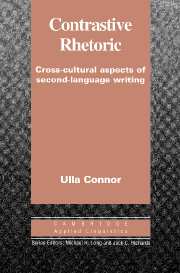Book contents
- Frontmatter
- Contents
- Series editors' preface
- Preface
- I PRELIMINARIES; EARLY PHASES OF THE FIELD
- II INTERFACES WITH OTHER DISCIPLINES
- III IMPLICATIONS OF CONTRASTIVE RHETORIC
- 9 Methods of research in contrastive rhetoric
- 10 Conclusion: Implications and research directions
- References
- Author index
- Subject index
10 - Conclusion: Implications and research directions
Published online by Cambridge University Press: 05 October 2012
- Frontmatter
- Contents
- Series editors' preface
- Preface
- I PRELIMINARIES; EARLY PHASES OF THE FIELD
- II INTERFACES WITH OTHER DISCIPLINES
- III IMPLICATIONS OF CONTRASTIVE RHETORIC
- 9 Methods of research in contrastive rhetoric
- 10 Conclusion: Implications and research directions
- References
- Author index
- Subject index
Summary
This book has defined an emerging contrastive rhetoric discipline that draws on several relevant interdisciplinary fields: text linguistics, composition and rhetoric, translation studies, and cultural studies of literacy. In English teaching situations, the extended definition of contrastive rhetoric takes us away from looking only at the effects of transfer from LI to L2 products. It leads us to the analysis of processes of writing as well as to studying the development of literacy skills in LI together with the effects of this development on L2 literacy. Thus, in addition to reviewing contrastive rhetoric research on cross-cultural writing styles and organizational patterns (Chapters 3 and 5), developments in the teaching of writing with emphasis on processes were discussed in Chapter 4. Chapter 6 discussed ways in which the acquisition and learning of literacy varies across cultures. The emphasis of Chapter 8 was on cross cultural variation in writing for specific genres such as research articles, business letters, resumes, and newspaper editorials.
Although teaching implications were woven throughout the chapters, this final chapter pulls together the major implications for teaching from three sets of findings: text linguistics, process-based composition instruction, and genre-specific research in EFL settings. Most would not consider contrastive rhetoric to be a method of teaching. It is an inquiry that provides a knowledge base to help ESL/EFL teachers and students. Though Kaplan (1966) maintained that the ESL teacher needs to be aware of differences between paragraph organization in different languages so that she can make these differences apparent to students, in later work he reasserted that contrastive rhetoric was not meant as a teaching pedagogy but as a knowledge and awareness about differences in writing patterns across cultures.
- Type
- Chapter
- Information
- Contrastive RhetoricCross-Cultural Aspects of Second Language Writing, pp. 166 - 174Publisher: Cambridge University PressPrint publication year: 1996



